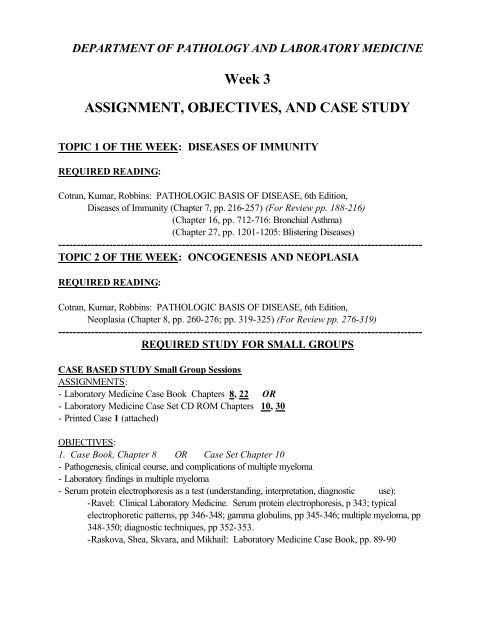Week 3 ASSIGNMENT, OBJECTIVES, AND CASE STUDY
Week 3 ASSIGNMENT, OBJECTIVES, AND CASE STUDY
Week 3 ASSIGNMENT, OBJECTIVES, AND CASE STUDY
Create successful ePaper yourself
Turn your PDF publications into a flip-book with our unique Google optimized e-Paper software.
DEPARTMENT OF PATHOLOGY <strong>AND</strong> LABORATORY MEDICINE<br />
<strong>Week</strong> 3<br />
<strong>ASSIGNMENT</strong>, <strong>OBJECTIVES</strong>, <strong>AND</strong> <strong>CASE</strong> <strong>STUDY</strong><br />
TOPIC 1 OF THE WEEK: DISEASES OF IMMUNITY<br />
REQUIRED READING:<br />
Cotran, Kumar, Robbins: PATHOLOGIC BASIS OF DISEASE, 6th Edition,<br />
Diseases of Immunity (Chapter 7, pp. 216-257) (For Review pp. 188-216)<br />
(Chapter 16, pp. 712-716: Bronchial Asthma)<br />
(Chapter 27, pp. 1201-1205: Blistering Diseases)<br />
----------------------------------------------------------------------------------------------------<br />
TOPIC 2 OF THE WEEK: ONCOGENESIS <strong>AND</strong> NEOPLASIA<br />
REQUIRED READING:<br />
Cotran, Kumar, Robbins: PATHOLOGIC BASIS OF DISEASE, 6th Edition,<br />
Neoplasia (Chapter 8, pp. 260-276; pp. 319-325) (For Review pp. 276-319)<br />
----------------------------------------------------------------------------------------------------<br />
REQUIRED <strong>STUDY</strong> FOR SMALL GROUPS<br />
<strong>CASE</strong> BASED <strong>STUDY</strong> Small Group Sessions<br />
<strong>ASSIGNMENT</strong>S:<br />
- Laboratory Medicine Case Book Chapters 8, 22 OR<br />
- Laboratory Medicine Case Set CD ROM Chapters 10, 30<br />
- Printed Case 1 (attached)<br />
<strong>OBJECTIVES</strong>:<br />
1. Case Book, Chapter 8 OR Case Set Chapter 10<br />
- Pathogenesis, clinical course, and complications of multiple myeloma<br />
- Laboratory findings in multiple myeloma<br />
- Serum protein electrophoresis as a test (understanding, interpretation, diagnostic use):<br />
-Ravel: Clinical Laboratory Medicine. Serum protein electrophoresis, p 343; typical<br />
electrophoretic patterns, pp 346-348; gamma globulins, pp 345-346; multiple myeloma, pp<br />
348-350; diagnostic techniques, pp 352-353.<br />
-Raskova, Shea, Skvara, and Mikhail: Laboratory Medicine Case Book, pp. 89-90
WEEK 3 - pg.2<br />
2. Case Book, Chapter 22 OR Case Set Chapter 30<br />
- Pathogenesis and clinical course of AIDS<br />
- Stages of HIV infection<br />
- Opportunistic infections in AIDS<br />
- Cytopenias in HIV infection<br />
- Laboratory evaluation of patients with HIV infection;<br />
Ravel: Clinical Laboratory Medicine, pp. 271-274<br />
- Laboratory detection of cytomegalovirus:<br />
Ravel: Clinical Laboratory Medicine, pp. 267-269;<br />
Raskova, Shea, Skvara, and Mikhail: Laboratory Medicine Case Book, p. 237<br />
- Histopathology<br />
- Relationship between serum albumin and serum calcium levels;<br />
Ravel: Clinical Laboratory Medicine, p. 420<br />
3. Printed Case (Attached)<br />
- Pathogenesis of diagnosed problems<br />
- Understanding of problems raised by questions for homework and discussion<br />
PATHTALK Small Group Sessions<br />
<strong>ASSIGNMENT</strong>S:<br />
- Projection slides on carousels in the Media Library, labeled by weekly topic and subject<br />
- Slide Manual (pp.30-35, Immunity; 36-38, Neoplasia)<br />
- Journal Club Article (see your Course Book)<br />
<strong>OBJECTIVES</strong>:<br />
- Correlations of histopathology, gross pathology, and laboratory findings<br />
- Review of pathophysiology<br />
------------------------------------------------------------------------------------------------------------------<br />
ADDITIONAL MATERIAL (Optional, unless indicated otherwise)<br />
-SELF-<strong>STUDY</strong> MATERIAL, MATERIAL FOR SELF EVALUATION and VISUAL <strong>AND</strong><br />
AUDIOVISUAL MATERIAL<br />
See your Course Book (page 4) for a complete listing.<br />
--------------------------------------------------------------------------------------------------------<br />
----------
WEEK 3<br />
DEPARTMENT OF PATHOLOGY <strong>AND</strong> LABORATORY MEDICINE<br />
“P R I N T E D” C A S E<br />
ROBERT WOOD JOHNSON MEDICAL SCHOOL<br />
DEPARTMENT OF PATHOLOGY<br />
IMMUNOLOGY<br />
Case Study #1<br />
petechiae and bruises accompanied by several episodes of epistaxis. Several days of watery diarrhea<br />
occurred two weeks before admission and for the past several days the patient has had "cold"<br />
symptoms, but without a fever. She was born at 34 weeks gestation with a birth weight of 2680 gms.,<br />
HISTORY: A 4-month old white female was admitted because of a one week history of generalized<br />
discharged at 3 days of age, and rehospitalized at 5 days of age because of hyperbilirubinemia, for<br />
which she received 12 hours of phototherapy. At birth her HIV serology was positive, but her complete<br />
blood count was normal. She was seen at 2 months of age for a well care visit and no petechiae were<br />
present. The mother, who is a known heroin addict and denies IV drug use during pregnancy, is HIV<br />
positive and has been on methadone maintenance.<br />
PHYSICAL EXAMINATION: The patient was well developed and well nourished in no acute<br />
distress. Vital signs were in the normal range. Generalized petechiae were present with an area of<br />
ecchymosis over the left knee. Liver was palpable 2.5 cm. below the right costal margin and a spleen<br />
tip could be felt. No lymphadenopathy was present. Deep tendon reflexes were slightly exaggerated.<br />
She smiled, cooed, followed visually, and pushed herself up. Her vital signs were normal.<br />
Hematology:<br />
LABORATORY DATA:<br />
Chemistry:<br />
WBC 11.300 [4-10 K/UL] Serum IgG 1060mg/dl [300-600]<br />
neutrophils 22 % [24 %] Serum IgM 230 mg/dl [30-60]<br />
lymphocytes 68 % [59 %] Serum IgA 108 mg/dl [10-55]<br />
monocytes 5 % [ 5 %] HIV serology Positive [Neg.]<br />
eosinophils 5 % [3 %] Toxoplasma serology Negative<br />
Platelet Count 28,000/mm 3 [140K - 340K] Epstein-Barr serology Negative<br />
Hgb 11.2gm/dl [10 - 14] Serum bilirubin 1.1 mg/dl [
Cytomegalovirus culture<br />
Negative<br />
COMMENT: Examination of the peripheral smear showed no significant red cell or white cell<br />
abnormalities. Platelets appeared markedly decreased in number.<br />
QUESTIONS FOR DISCUSSION:<br />
1. What is the correlation between the lab data and the presenting symptoms and<br />
physical findings Explain.<br />
2. What was the cause of the hyperbilirubinemia at 5 days of age<br />
3. What is the most likely diagnosis<br />
4. What is the epidemiology of HIV infection What are the possible origins and routes of the<br />
infant’s infection<br />
5. Why are the serum immunoglobulins elevated What are some other immune function<br />
abnormalities




